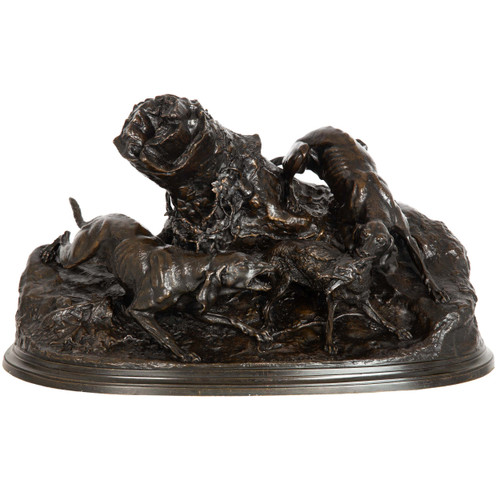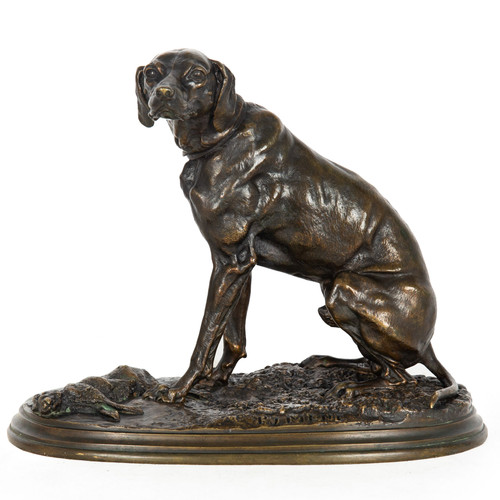-

-

-

-

Mene, Pierre-Jules
Hunt Plaque of Hare & Pheasant (1850) | Pierre-Jules Mene
Regular Price: $3,700.00 -

-

Mene, Pierre-Jules
"Chien Braque Assis Gardant un Lapin" | Pierre Jules Mene
Regular Price: $3,900.00 -

-

-

Mene, Pierre-Jules
"Chasse au Canard" | Pierre Jules Mene (French, 1810-1879)
Regular Price: $5,500.00 -

Mene, Pierre-Jules
"Valet de Limier" | Pierre Jules Mene, cast by F. Barbedienne
Regular Price: $8,500.00 -

Mene, Pierre-Jules
"Chien Epagneul-Griffon Saisissant un Canard" (1848) | Pierre Jules Mene
Regular Price: $6,750.00 -

Mene, Pierre-Jules
Pierre-Jules Mêne (1810-1879) was one of the most successful and prolific animalier sculptors of the 19th century, known for his naturalistic representation of animals. Born on March 25, 1810, in Paris, Mêne was the son of a metal turner, which allowed him early exposure to the techniques of metalworking that would prove crucial to his artistic career.
Mêne received no formal education in sculpture but was taught to draw and model by his father and later began casting his own sculptures. He was largely self-taught, possessing a keen observation of nature that enabled him to capture the essence of his animal subjects with remarkable accuracy and vivacity.
His work debuted at the Paris Salon in 1838, and from that point onwards, he exhibited his sculptures regularly. Mêne specialized in small-scale domestic animals, his subjects often including horses, dogs, bulls, and sheep. Interestingly, almost no big game are found in Mêne's ouevre.
Beginning in 1837 as orders started coming in, Mêne worked as Antoine-Louis Barye before him, opening his own foundry where he personally oversaw the manufacture and production of his art. The work produced there bears the hallmark of extraordinary attention to detail and thoughtfulness shown in every element of presentation and assembly. His mastery in the technical aspects of casting bronze without relying on professional founders for the completion of his models gave him a significant advantage in producing his pieces with fine detail and at a lower cost. This operation was expanded in 1852 to handle the casting of models for his new son-in-law, Auguste Cain.
Mêne’s sculptures are characterized by their naturalistic detail and the sense of immediate and candid snapshots of the animals in their daily lives. The essence of these qualities is captured in L'Accolade, a group that would become his best-known sculpture and clearly was a cherished favorite demanded by his clients.
In the 1850s, Mêne's work gained international fame, and he started receiving commissions from patrons across Europe. His success was such that his sculptures were reproduced widely, in different sizes, and his foundry became one of the most prominent in Paris for animal bronzes. To this end, as an avenue into the profitable English market, he made arrangements with the Coalbrookdale foundry and the Falkirk foundry to cast some of his models.
Mêne’s artistic contributions were recognized with several awards during his lifetime. He was awarded first-class medals at the Expositions Universelles in Paris in 1855, 1861, and 1867, and he was made a Chevalier of the Legion of Honor in 1861.
Mêne's commitment to realism, at a time when the academic tradition still dominated art, was innovative and influential. He is often mentioned alongside artists like Antoine-Louis Barye and Auguste Caïn, who also contributed to the popularity of the animalier school in France.
After a prosperous career, Pierre-Jules Mêne died in Paris on May 20, 1879. His foundry continued to operate under the direction of his son-in-law, Auguste Cain, for the benefit of Julie Mêne and her children. This allowed Mêne’s influence to persist beyond his death and eventually the rights to cast 217 models were sold to Susse Freres along with rights to edit 110 of Auguste Cain's models. Susse produced a catalogue featuring the work of the two artists and continued to produce their work well into the 20th century.
There is always great confusion around which models are cast during Mêne's lifetime, which were cast under the careful eye of Auguste Cain after 1879 and which were produced outside of those two operations. We have handled many examples from a full spectrum of foundries and can attest to the fine quality that can come from foundries even after Mêne's lifetime, which only compounds the confusion. It is only with careful study and comparison against known examples, acute observation of the construction methods and awareness of surface qualities that a piece can be firmly attributed to a specific period of production. Lifetime casts are quite rare and difficult to find, so we recommend these are only purchased from dealers very familiar with Mêne's work and the nuance around his sculpture and who have handled a great deal of his work personally.
Today, the works of Mêne are held in numerous private collections and museums worldwide, including the Louvre and the Musée d'Orsay in Paris. In terms of reputation, he was second only to the great father of the Animaliers, Antoine-Louis Barye. Mêne remains celebrated for his contributions to French art and the animalier genre, and his sculptures are highly sought after by collectors for their beauty and lifelike quality.
Literature & Further Reading:
- Pierre-Jules Mêne, 1810-1879: Catalogue raisonné, Poletti & Richarme, 2007
- Animals in Bronze, Christopher Payne
- The Animaliers, James Mackay; reproduction of Mene's catalog on p. 147-151
- Bronzes of the 19th Century: Dictionary of Sculptors, Pierre Kjellberg, p. 469-483
- E. Benezit Dictionary of Artists, Vol. IX, Gründ, 2006, p. 760
- Bronze Sculpture of Les Animaliers, Jane Horswell
- Art Bronzes, Michael Forrest, 1988
- Dictionnaire des Sculpteurs de L'École Française, Vol. III, Lami, 1919, p. 427-30
